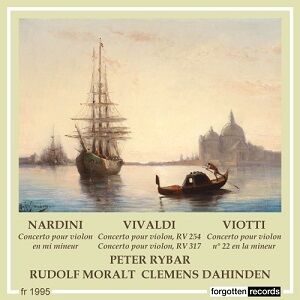
Antonio Vivaldi (1678-1741)
Violin Concerto in E flat, RV 251, F1 R254, Op.31 No.2
Violin Concerto in G, RV317, F1, R462
Pietro Nardini (1722-1793)
Violin Concerto in E arr. from Viola Sonatas and arr. Concerto by Miska Hauser
Giovanni Battista Viotti (1755-1824)
Violin Concerto No.22 in A, G97 (1792/97)
Peter Rybar (violin)
Vienna Symphony Orchestra/Rudolf Moralt (Vivaldi)
Winterthur Symphony Orchestra/Clemens Dahinden
rec. 1949-50, Vienna (Vivaldi); 1951, Winterthur (Nardini and Viotti)
Forgotten Records FR1995 [72]
Peter Rybar (1913-2002), born in Vienna to Czech parents, was an admired soloist, quartet leader and orchestral concertmaster. His recordings for Westminster, Concert Hall and Le Chant du Monde are prized examples of his stylish and virtuosic playing and this particular disc reflects his command of Baroque repertoire in Westminster discs made between 1949 and 1951.
Between December 1949 and early January 1950, Rybar was in the city of his birth recording two Vivaldi concertos with the Vienna Symphony and Rudolf Moralt, a time when Vivaldi’s concertos were very much less ubiquitous than they are now. Rybar was a fine exponent of this music. His tone was finely focused, and he cultivated a precision and directness that suited it adeptly, added to which his intonation was invariably spot-on. Moralt employed a harpsichord and supports his soloist well, Rybar’s turns of phrase remaining at all times refined. The E flat concerto is notable for his modernity of tonal production though it’s also the case that there’s a whacking great edit in the finale at 2:06, a movement where the harpsichord is more prominent than before, and Rybar’s pirouetting violin full of communicative bravura. Where Vivaldi pushes the violin up quite high in the E flat, in the Concerto in G he is more generous, allowing the music to be statelier. It’s true that Moralt’s orchestra is very much ‘School of 1950’ regarding saturation of string tone – not making much of a distinction between Vivaldi and Brahms in that respect, especially in the slow movement – but even so this is an engaging performance. Rybar plays with rapt lyricism in the Largo and with robust self-assertion in the finale.
The Nardini and Viotti coupling was made with the Winterthur Symphony Orchestra and Clemens Dahinden in 1951. Who knows, it’s possible it inspired Mischa Elman’s stereo coupling of the Nardini with a Vivaldi concerto and Bach’s E major, a disc he made in Vienna for Vanguard a decade later. Needless to say, Rybar shows the older man a clean pair of heels in matters of tempo, rhythm and directness of phrasing in the Nardini. Rybar’s violin is fractionally more integrated into the orchestral picture than had been the case in Vienna and he charms especially in the cantabile of the central movement. Viotti’s 22nd Concerto is a famous case of a piece rather more talked about, admired and dissected in the practice or teaching room than recorded, though some major figures have managed to get it on to disc – Perlman, Stern, Grumiaux, Menuhin, Oistrakh and Shumsky among them; not a bad list. It was a favourite concerto of Brahms and it’s always been said that he based the finale of his Violin Concerto on the Viotti. It has quite a few traps for the unwary fiddler and for those reluctant to practising. Possibly that’s why Kreisler never made his recording in London in the mid-30s, as he was supposed to. There are some fiendish-sounding string crossings and some uncompromisingly tough trills, as well as a long cadenza to surmount, all of which presented few problems to Rybar. Many players chose the Ysaÿe cadenza – though Perlman went for the David, which he amended – but there’s one by Joachim which is the one, I think, Rybar plays. One has to be careful about this, as there are cadenza fetishists about. Rybar and Dahinden generate fine rapport, and deal justly with the expressive elements of the Adagio and in the dance finale with its dashing, vitalising solo line. The orchestra probably wouldn’t meet the standards of today, but it’s 1951 we’re talking about.
The transfers are highly accomplished and gimmick-free. There are no notes, as usual from this source. Rybar’s admirers have this disc to enjoy as an admirably baroque-focused collection – until some enlightened label gets to grips with his whole legacy and gives admirers a well-deserved box set.
Jonathan Woolf
| Availability |  |


















